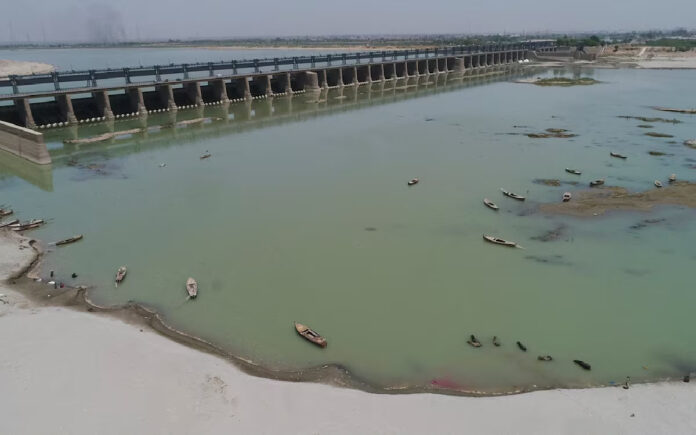Latifabad: Spraying pesticides on his parched vegetable crops just a street away from the Indus River, Pakistani farmer Homla Thakhur watches anxiously as the water levels continue to drop. The sun blazes overhead, the river runs alarmingly low, and fears mount after India vowed to cut off water supplies following a deadly militant attack in Kashmir.
“If they stop water, all of this will turn into the Thar desert, the whole country,” said Thakhur, 40, as he prepared to refill his spray gun tank.
“We’ll die of hunger.”
Thakhur’s 5-acre (2-hectare) farm lies in the Latifabad area of Sindh province, where the Indus River — originating in Tibet — winds through India before reaching Pakistan and emptying into the Arabian Sea. His concerns are shared by more than 15 Pakistani farmers and agricultural experts, especially after years of reduced rainfall.
In an unprecedented move, India on Wednesday suspended the World Bank-brokered Indus Waters Treaty of 1960, a pact that guarantees water for around 80% of Pakistan’s agricultural lands. India declared the suspension would remain in effect until “Pakistan credibly and irrevocably abjures its support for cross-border terrorism.”
New Delhi alleges that two of the three militants who attacked tourists and killed 26 people in Kashmir were Pakistani nationals. Islamabad, however, has strongly denied any involvement and warned that “any attempt to stop or divert the flow of water belonging to Pakistan … will be considered as an Act of War.”
The treaty originally divided the Indus River and its tributaries between the two nuclear-armed neighbors. Although India currently lacks the infrastructure to halt water flow immediately — as the agreement only allowed it to build hydroelectric plants without major storage facilities — government officials suggest that change could begin within months.
“We will ensure no drop of the Indus River’s water reaches Pakistan,” India’s Water Resources Minister Chandrakant Raghunath Paatil declared on X (formerly Twitter).
He did not respond to inquiries regarding the growing apprehensions in Pakistan.
Two Indian government officials, speaking anonymously due to the sensitivity of the matter, stated that India could soon start diverting water to its own farms via canals, while laying groundwork for large hydroelectric dams that may take between four to seven years to complete.
In the short term, India plans to cease sharing critical hydrological data, withhold flood warnings, and skip annual meetings under the Permanent Indus Commission, according to Kushvinder Vohra, a former chief of India’s Central Water Commission.
“They will not have much information with them when the water is coming, how much is coming,” said Vohra, who also previously served as India’s Indus Commissioner and now occasionally advises the government.
“Without the information, they cannot plan.”
Beyond agriculture, economists warn that a water shortage could have devastating effects on electricity generation and the broader economy.
Vaqar Ahmed, economist and team lead with UK-based Oxford Policy Management, noted that Pakistan had underestimated the risk posed by India’s possible exit from the treaty.
“India hasn’t got the kind of immediate infrastructure to halt the waterflows, especially during flood times, so this period creates a crucial window for Pakistan to address the inefficiencies in its water sector,” he said.
“There are a lot of inefficiencies, leakages.”
Longstanding Disputes Resurface
Over recent years, Indian Prime Minister Narendra Modi’s administration has been pushing to renegotiate the treaty. Simultaneously, India and Pakistan have been contesting the specifications of the Kishenganga and Ratle hydroelectric projects at the Permanent Court of Arbitration in The Hague, particularly concerning water storage capacities.
“We can now pursue our projects in free will,” said Vohra.
In a formal communication to Pakistan, India argued that circumstances had significantly evolved since the treaty’s signing — citing population growth and the increasing demand for clean energy sources like hydropower.
A spokesperson for the World Bank clarified that while it is a “signatory to the treaty for a limited set of defined tasks,” it does “not opine on treaty-related sovereign decisions taken by its member countries.”
Also Read | Trump’s Next 100 Days: Focus on Trade Deals, Peace Efforts, and Major Policy Shifts
Farmers like Nadeem Shah, who cultivates cotton, sugarcane, wheat, and vegetables on his 150-acre farm in Sindh, are growing increasingly anxious about their access to drinking water.
“We have trust in God, but there are concerns over India’s actions,” he said.
The three rivers allocated to Pakistan support irrigation for over 16 million hectares — approximately 80% of the country’s farmland — and are crucial for the survival of a population of nearly 240 million.
Ghasharib Shaokat of Pakistan Agriculture Research in Karachi highlighted the instability that India’s move injects into the region.
Also Read | Deadly Crash at Vancouver’s Filipino Festival Leaves Multiple Victims
“India’s actions inject uncertainty into a system that was never designed for unpredictability,” he said.
“At this moment, we don’t have a substitute. The rivers governed by the treaty support not just crops, but cities, power generation, and millions of livelihoods.”
The Indus Waters Treaty had survived even as India and Pakistan fought four wars since their partition in 1947. However, the current suspension raises fresh concerns about future conflicts.
“We’re already locked into generations of conflict, and by exiting the Indus Water Treaty, I believe we’re locking future generations into a brand new context of conflict,” said Bilawal Bhutto Zardari, Pakistan’s former foreign minister.
“That must not happen.”



